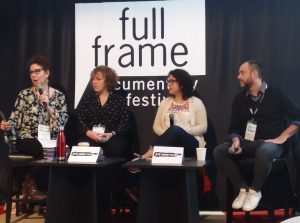
Toby Shimin, editor for This Is Home; Penelope Falk, the editor for STEP; Carla Gutierrez, editor for RBG; George O’Donnell, editor for Jackie Robinson
When I looked at the schedule for the Full Frame Festival, I knew instantly which session I had to attend. The cleverly titled, Running with Scissors session featured a panel of accredited and award-winning editors that shared their insight on documentary editing. As a video editor myself, I looked forward to soaking up any gems of knowledge that could help me on my road to becoming a documentary video editor.
The night before the panel, RBG premiered at the festival. I was in complete awe of the precision, creativity, and timeliness of the edit. Compact with powerful interviews and a great deal of archival footage I was very eager to know what the hardest part of the edit was. During the question and answer period after the film I asked the film’s editor, Carla Gutierrez, this question. She confessed that finding the story within all of the archival footage was the most challenging. Inspired by her work, and a little fan struck, I went up to her after the Q&A and asked her if she had any advice for new documentary film editors. Her response was to find a mentor to learn and work under. We talked more and I thanked her for her willingness to share her insights.
The next morning, I made the connection that Ms. Gutierrez was also going to be on the Running with Scissors panel and my excitement and nervousness resurfaced. Accompanying her was Toby Shimin, the editor for This Is Home, Penelope Falk, the editor for STEP, and George O’Donnell, the editor for Jackie Robinson. Over the next hour these seasoned editors shared their personal journey to becoming successful documentary editors.
Falk talked about how she experienced a time when she wasn’t getting call backs and had to reevaluate her demeanor in the edit room and have honest conversations in the beginning of projects about her assertiveness and how she worked. I admired that level of transparency that she shared and made mental notes to do the same. O’Donnell shared how it was okay to set boundaries with your producer in terms of needing time alone to complete notes after an edit session. Again, this was reassuring that other editors feel this way and it is okay to voice this need for space. Gutierrez echoed what she shared to me the night before, testifying that surrounding yourself with mentors and other editors is key towards your journey as a documentary film editor.
One of the most precious gems that was shared was the advice to in the beginning of an edit find the very best moment in your piece, the moment that you know will be in the final version, and cut that first, then begin to play with the rest of the piece. This was shared by Tobi Shimin whose film, This is Home, I saw later that day. This is Home was a brilliant vérité edit that pulled at your heart stings. After the film was shown and I went up to Toby Shimin and asked the same question that I asked Carla Gutierrez, What is your advice for emerging documentary film editors? Most of her answer echoed Gutierrez’s response about finding a mentor but she also added that contacting the Center for Documentary Studies at Duke or at your university to volunteer on projects would be a great way to begin to get documentary film editing experience. She left me with an encouraging note that she looks forward to my film being shown here someday.
This entire experience was exactly what I needed to re-light the fire of my passion for editing. Seeing all of the different films that were cut so creatively and more importantly the conversations that I shared with editors and directors after their films aired was truly priceless.
